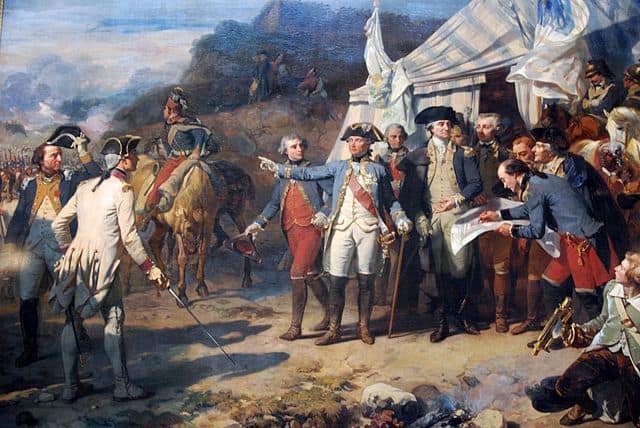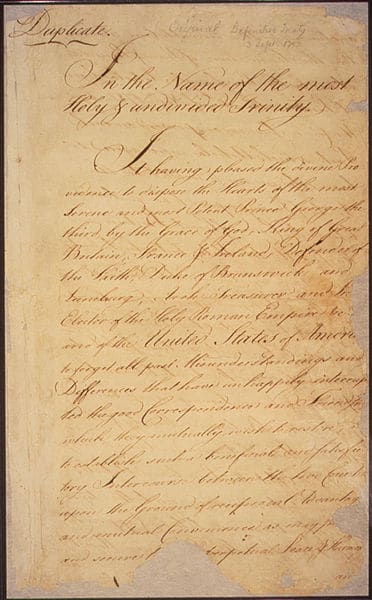Top 10 facts about the Treaty of Paris and the American Revolution
As an American myself, I’m embarrassed to say that I didn’t realize how involved France was in the American Revolution. Maybe I just wasn’t paying attention in history class!
Now that I know, I feel extremely thankful for the role that the French played in helping America declare independence from Great Britain all of those years ago. The Treaty of Paris helped bring an end to the Revolutionary War, and it was signed in, you guessed it, Paris, France!
Keep reading to learn more about the Treaty of Paris and the American Revolution!
1. The Treaty of Paris ended the American Revolutionary War

Siege of Yorktown. General Rochambeau and general Washington give last orders before an attack, October 1781 by Auguste Couder – WikiCommons
The American Revolutionary War was a battle between the 13 original colonies and Great Britain for control over America. The war officially broke out in 1775, and the original colonies declared their independence in 1776.
By the time 1781 rolled around, the British had surrendered at Yorktown, and all sides were ready to see the war come to an end. However, even after the battle at Yorktown, smaller battles continued to wage between the British and the colonies for almost 2 years. The British King George III was not ready to let go of his colonies in America.
Finally, in February 1783, King George issued a Proclamation of Cessation of Hostilities, which brought the fighting to an end. It actually took a very long time for the war to officially end, and for the 13 colonies to officially become the United States of America. More on all of these details coming up!
2. There are two very important points in the Treaty of Paris
In addition to ending the American Revolutionary War, the Treaty of Paris included many terms that both the British and the Americans were required to adhere to. These terms were, of course, in favor towards the Americans.
There are two very important points in the Treaty of Paris that I’d like to mention here. The first, and arguably the most important, is that the 13 colonies were no longer under Britain’s control, and were to be considered free and independent.
The second important point is that the new borders that were agreed upon allowed for western expansion. This point may have not been very important at the time, but in later years when Americans began to explore the west, it would make things much easier!
3. King George III didn’t sign the Treaty of Paris himself
Like all good kings, King George III had several people working for him. And by several, I mean several hundreds, if not thousands. He was the king of the British Empire after all, which was very large at the time.
Rather than signing the Treaty of Paris himself, King George III sent a representative to do it for him. While this may sound strange, it was quite normal at the time. Kings just weren’t seen out and about, even if it was to sign an important treaty that would bring a bloody war to an end.
King George III sent two men to represent him: David Hartley and Richard Oswald. Hartley was a statesman and an inventor, and Oswald was a merchant and a slave trader. Both are best known as the “peace commissioners” that signed the treaty.
4. Three important Americans signed the Treaty of Paris
America sent three men to sign the Treaty of Paris. Benjamin Franklin, John Jay and John Adams. Adams was the Diplomat to France, and was sent to Paris to start negotiations in 1782. All three of the men are considered to be Founding Fathers of the United States.
Franklin is known for his writing, his scientific discoveries, and his inventions. Franklin invented the lighting rod, bifocals, and the Franklin Stove.
Jay is known as an abolitionist and for his involvement in the development of the new United States of America. He is also famous for signing the Treaty of Paris.
Adams is known for his writing, and his diaries are famous and well read. They are a great historical document to reference to discover the goings on of the 18th century. Adams was also the 2nd president of the United States!
5. The Treaty of Paris was signed in 1783, but the British surrendered in 1781
I’ve already mentioned that the British surrendered at Yorktown in 1781. But, that didn’t mean that the war was officially over, or that the 13 colonies were officially independent. Like most things, negotiations took a very long time. I like to think that this is because King George III was less than thrilled to give up his American colonies.
It took about one and a half years for King George to ratify the treaty. The British surrendered at Yorktown on October 19, 1871. John Adams was sent to France for negotiations in 1782, and the Treaty of Paris was signed by the Americans and the British on September 3, 1783.
6. Spain was also involved in the American Revolutionary War and the Treaty of Paris

Spanish troops led by Bernardo de Gálvez in combat against the British at Pensacola by Augusto Ferrer Dalmau – WikiCommons
In addition to France, Spain was also involved in the American Revolutionary War. In 1782, the French were ready for the war to be over, but Spain resisted. They wanted the war to continue so that they would capture the British colony of Gibraltar.
The French Foreign Minister at the time, Charles Gravier, Count of Vergennes, managed to convince Spain to take a different deal. To compensate for Gibraltar, Spain was given the area south of the Ohio River. Spain would be able to set up was was called an “Indian barrier state” that was controlled by Spain. The concept of this barrier state was essentially a buffer between the United States and Spanish territory.
Spain was also given Florida as a part of the deal.
7. The Treaty of Paris included several different terms

Commemorative plaque of the treaty of Paris, affixed on the building of rue Jacob (N° 56) where the treaty was signed by Mu – WikiCommons
I’ve already touched on some of the most important terms of the Treaty of Paris, but the treaty itself was made up of 10 key points. The first two you’ll find more in depth above: the independence of the United States and the new boundaries.
The other points included fishing rights (this was important stuff back then!), a new law that required debtors to pay their debts, another law required that all seized property be returned to their rightful owners (those that supported King George were called « Loyalists, » and they were persecuted during the war), all Prisoners of War were to be released, both Great Britain and the United States were given access to the Mississippi River, and the treaty was required to be ratified within six months of it’s signing date.
8. There is an unfinished painting depicting the signing of the Treaty of Paris
In celebration of the end of the Revolutionary War and the Treaty of Paris, artist Benjamin West began a painting depicting the singing of the treaty. West was American, and wanted to share the good news with the world!
The painting was never finished, as while the American representatives agreed to pose for the painting, the Brits refused. In addition to Franklin, Jay and Adams, the United States peace commissioners included Henry Laurens and William Temple Franklin. The unfinished painting shows the group of five, and a blank space beside them, as you can see above.
9. There is only one article from the Treaty of Paris that still stands today
Due to many changes after many years, there is only one article from the Treaty of Paris that still stands today. It is “Article 1” and it states that,
“Britain acknowledges the United States (New Hampshire, Massachusetts Bay, Rhode Island, and Providence Plantations, Connecticut, New York, New Jersey, Pennsylvania, Delaware, Maryland, Virginia, North Carolina, South Carolina and Georgia) to be free, sovereign, and independent states, and that the British Crown and all heirs and successors relinquish claims to the Government, property, and territorial rights of the same, and every part thereof,”
Basically, the only article from the Treaty of Paris that is still recognized today is that the original 13 colonies are independent from Great Britain and the Crown.
10. There are several Treaties of Paris
As there were several countries involved in the American Revolutionary War, it makes sense that there were several treaties that needed to be signed in order to end the conflict.
The group of treaties are referred to as the “Peace of Paris.” The Treaty of Paris was signed, as we know, in Paris on September 3, 1783. There were then two other treaties signed at Versailles between the French king and the Spanish king soon after.
There was also another treaty that was drafted on September 2 between the French and the Dutch. This treaty, while it doesn’t refer directly to the American Revolutionary War, is also related. The Dutch and the British experienced difficulties during the war as the Dutch wanted to continue trade with the 13 colonies and the British did not appreciate it (to put it lightly). This treaty was not officially signed until May 20, 1784.
Conclusion
Now you know some important facts about the Treaty of Paris and the American Revolution! Did you know that there were several different countries involved in the conflict? Did you know that it took months for the Treaty of Paris to actually be ratified by King George III? Well…know you know!
If you want to learn more about French history, why not going one of our walking tours the next time you are in Paris? Our local guides really know their stuff, and Paris is practically an open history book just waiting to be explored! Click here to learn more about all of the options and to make your booking.
Planning a trip to Paris ? Get ready !
These are Amazon’s best-selling travel products that you may need for coming to Paris.
Bookstore
- The best travel book : Rick Steves – Paris 2023 – Learn more here
- Fodor’s Paris 2024 – Learn more here
Travel Gear
- Venture Pal Lightweight Backpack – Learn more here
- Samsonite Winfield 2 28″ Luggage – Learn more here
- Swig Savvy’s Stainless Steel Insulated Water Bottle – Learn more here
Check Amazon’s best-seller list for the most popular travel accessories. We sometimes read this list just to find out what new travel products people are buying.















